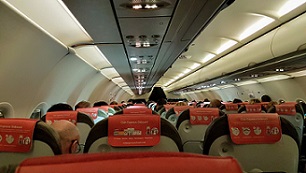 The last place you want a lithium battery fire is in the confined space of a passenger aircraft
The last place you want a lithium battery fire is in the confined space of a passenger aircraft
 An AvSax lithium battery fire containment bag which won the Queen’s Award for Enterprise for its sheer innovation
An AvSax lithium battery fire containment bag which won the Queen’s Award for Enterprise for its sheer innovation
 Environmental Defence Systems managing director Richard Bailey
Environmental Defence Systems managing director Richard Bailey
A mobile phone sparked a fire scare on a passenger plane heading for London after it was crushed in a seat.
The incident happened on a United Airlines flight from San Francisco to Heathrow when a passenger’s mobile phone fell between the seat and the armrest.
The seat was moved from the reclined to the upright position which crushed the phone and smoke then began to spiral from it. A flight attendant placed the phone in a thermal containment bag and the flight continued to Heathrow where it landed safely.
The only figures made public in the world about lithium battery incidents on planes come from the Federal Aviation Administration in the USA which collates them from US airline operators or aircraft in US airspace … and it has just revealed information about the latest United Airlines incident which happened on March 13.
Since March 2006 the FAA has recorded 476 incidents – 199 involving battery packs, 99 caused by vapes or e-cigarettes, 61 mobile phones, 58 laptops and the rest from other personal electronic devices.
As these are only FAA figures it means many more incidents will have happened in other parts of the world but are never made public. That includes the Civil Aviation Authority in the UK.
Phones getting crushed in seats are a particular danger which is why cabin crew warn people during their pre-flight safety checks to alert them immediately if they lose a phone down a seat or their electronic device starts to overheat.
This is because they can then act quickly to deal with the problem before it escalates into a fire or, in the worst scenario, the battery exploding.
When a lithium battery overheats it goes into a chemical process called thermal runaway and when this happens one cell in a battery can produce enough heat – up to 900°C (1652°F) – to cause adjacent cells to overheat. This can cause a lithium battery fire to flare repeatedly and they are then very difficult to put out which is why fire mitigation bags are so important, especially in the confined space of aircraft passenger cabins.
Many passenger aircraft now carry these lithium battery fire mitigation bags and the most widely used by far is the AvSax from British company Environmental Defence Systems Ltd.
The company is based in Huddersfield, West Yorkshire, and won the Queen’s Award for Enterprise for the AvSax’s innovation, the highest accolade any business can achieve in the UK.
AvSax are now on almost 17,000 planes operated by around 100 airlines worldwide and has been used in action dozens of times.
Environmental Defence Systems managing director Richard Bailey said: “People are now becoming more and more aware of the potential hazards on planes of mobile phones and other personal electronic devices such as battery chargers and iPads powered by lithium batteries.
“The last place you want a lithium fire is in the confined space of a passenger aircraft with the toxic smoke it gives off and the potential for the device to catch fire and even explode.
“Incidents remain rare but they do happen and if planes are not equipped with AvSax they often have to divert and make an emergency landing at the nearest airport which is costly for the airline and very disruptive for passengers.
“This is why so many airline companies – including some of the biggest names in the industry – have AvSax for that peace of mind that they are ready for any lithium battery incident. AvSax have been deployed in action well over 30 times and in every incident the flight has safely continued to its final destination.”